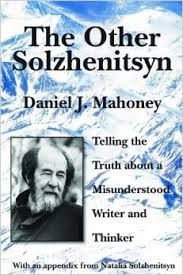Don't Bet Against the Zek
Does Aleksandr Solzhenitsyn (1918-2008), who was among the great 20th-century heroes in the fight against communism, matter today?
As significant as anything that Solzhenitsyn did, Richard Brookhiser pointed out, was to “introduce one word into the world’s vocabulary: gulag (Russians knew it already).” What Solzhenitsyn accomplished with “gulag” was to change the “iconography of modern despotism.” He taught Westerners that communism meant lies and violence.
Few would deny this, but it is largely a historical claim. Solzhenitsyn “taught” us. Now that the main lines and even most details of Solzhenitsyn’s revelation of communist repression and evil have been vindicated, does he have anything to say to us positively about liberty, politics, and the human soul?
Daniel J. Mahoney, one of the finest American interpreters of Solzhenitsyn, thinks there is more to Solzhenitsyn than the historical point. The Other Solzhenitsyn is, he says, a “bet on the continuing relevance” of a man “subject to more misinterpretations and calumnies” than any other recent writer or thinker. Mahoney aims to tear away the false image of Solzhenitsyn as having been anti-Western, anti-democratic, pan-Slavist, virulently nationalist, anti-Semitic, and nostalgic for monarchy, while showing him to be a “lucid lover of country,” a “man of faith and reason,” and indeed a “theorist of self-government.”
It isn’t just that Solzhenitsyn taught, but that he teaches. We have much to learn.
How was Solzhenitsyn so misinterpreted in the first place? The misapprehensions began in the 1970s when Solzhenitsyn showed, in the Nobel Prize and Harvard addresses, that while he was a friend of the West, he was a critical friend. He declined to sign on to an “end of history” as written by secular liberal theorists upon the Soviet Union’s collapse. Secular liberal theorists thus greeted his continuing interest in Russia as simply “extreme nationalism” or Tsarist nostalgia. Their views of the man remained, as Mahoney says, permanently in the 1970s—and wrong to boot. Meanwhile in Russia, particularly after 1989, Solzhenitsyn’s repeated denunciation of communism, insistence on a moderate patriotism, and interest in learning some lessons about liberty from the West earned him a reputation on the Russian right as a traitor to “eternal” Russia.
Mahoney does think that Solzhenitsyn is responsible in part for the misinterpretations. He locates the problem primarily in “tone.” For one thing, Solzhenitsyn tended to treat his readers as serious adults who could handle difficult conversations. Mahoney’s chapter on Two Hundred Years Together, Solzhenitsyn’s 2003 exploration of the history of the Jews in Russia, shows that his main points about Russian treatment of the Jews before and after the Revolution, the significant initial Jewish support of the Bolsheviks, and the targeting of Jews by Stalin from the 1930s on, were all historically sound. But to simply weigh in on such matters without taking due notice of contemporary “sensitivities” when talking about them was bound to bring a hailstorm of unfair criticisms from reporters and activists from all camps who wanted a “score” showing either Jewish or Gentile Russians to be the real, permanent holders of the victim card.
Solzhenitsyn also occasionally made hyperbolic claims, as when he compared the Western bombing of Serbia in the 1990s to the actions of the Nazis. Nor were his judgments on contemporary political developments always above criticism. In the 1970s, Solzhenitsyn believed the Club of Rome’s predictions of ecological catastrophe. In the 1990s he rejected an award from the Yeltsin government because he believed it to be a corrupt kleptocracy, but did accept an award during the Putin era.
Mahoney is at pains to show (accurately) that Solzhenitsyn was not an uncritical supporter of the Putin regime, but the defense occasionally seems strained. Taking a stand against corruption but then lending his dignity to a successor who advanced a narrative of Soviet-Russian continuity—one that was anathema to Solzhenitsyn himself—was clearly a mistake. National repentance was part of Solzhenitsyn’s way forward for his nation in communism’s wake; Putin refused to repent of this past, and Solzhenitsyn himself gradually realized this. It was an unfortunately blurred close for a thinker who had typically drawn the brightest of moral and political lines—indeed, Mahoney describes Solzhenitsyn’s views about Russia’s prospects at the time of his death in 2008 as “too sanguine.”
But to focus on such issues would detract from Mahoney’s main goal of demonstrating that the great man has something to offer beyond historical witness and analysis of Soviet totalitarianism—and certainly much more than any mistaken particular judgments during his 92 years of life. One can deeply sympathize with an old man who has seen the fall of an evil regime and now looks with eyes too tinted by hopefulness. It is Solzhenitsyn the political thinker and artist who should be remembered, not Solzhenitsyn the pundit.
Yet even on this score, in general, Mahoney’s new book is less critical of Solzhenitsyn than his 2001 volume, Solzhenitsyn: The Ascent from Ideology, where he could note the tendency toward a “conservative romanticism” in Solzhenitsyn’s writings, as well as criticize a failure to understand the importance of partisan politics in modern representative governments. In this new volume, the romanticizing tendency is unmentioned and, while the under-appreciation of politics is reiterated, it comes with the caveat that even though Solzhenitsyn failed to adequately distinguish constitutional parties from their totalitarian counterfeits, his “eminently sensible” view was that one needs to be able to vote for actual candidates who can be held personally responsible.
It is this personal element of his political thinking that is so important. Solzhenitsyn was less a proponent of democracy, Mahoney writes, than he was an enemy of ideological despotism which attempted to efface the divine image in man by taking away his liberty, his natural rights, and his responsibility. Like Tocqueville, John Stuart Mill, Friedrich Hayek, and John Paul II, he recognized that democracy itself could be turned into an ideology that steals those humane qualities in a more covert way. But Mahoney emphasizes that Solzhenitsyn did often look to Western models for inspiration for post-Soviet Russia, pointing especially to Swiss cantons and small-town government in New England. He quotes the man himself saying that he “always insisted on the need for local self-government for Russia, but never opposed this model to Western democracy.”
This localism has been remarked upon before. (Solzhenitsyn biographer Joseph Pearce recounts discussing in an interview the similarities of his thought to that of E. F. Schumacher and G. K. Chesterton.) But it is important to note that Solzhenitsyn, like the American Founders, understood that while self-government had to be local, “from the ground up,” it had to be supported by a strong central government, what the Russian writer called the “vertical of power.” The central government’s task was certainly to defend the nation, but Solzhenitsyn warned that foreign military adventurism distracted it from its other main task: to provide breathing room, infrastructure, and resources for local entrepreneurial and governmental initiative. He looked to the zemstvo, local and provincial councils that operated in the years before the revolutions, as models from the past that could be prudently modified in building up a Russia that was self-governing and free.
If Solzhenitsyn was too sanguine about Putin (and Mahoney guesses his voice would be more critical today), it was because Putin had at least restored a degree of pride in the Russian nation. If there is to be a democracy, there must be a demos that considers itself as such and takes pride in itself. The soul of a nation needs to be great if it is to be magnanimous and humble. And a great-souled nation needs to see itself as “under God” in order to be limited.
The lack of limits is his theme in commenting on “the crisis of modern progress” in his 1993 farewell address to the West. Progress is seen as a “stream of unlimited blessings,” but it is really a gift given from God for an “extremely difficult trial of our free will.” Moreover, technological and economic progress can never be confused with moral progress. Nor can external freedom be confused with internal freedom. In each case, the former can serve the latter but if allowed to proceed unbounded, can turn destructive of moral progress and internal freedom. The alternatives for individuals are the same as they are for nations: self-limitation or tyranny. And the path to finding self-limitation, humility, and moral responsibility is in religious faith.
Mahoney argues, as he did in his first book, that Solzhenitsyn’s religious views are not simply reflective of his experience as an Orthodox Christian. Instead, his embrace of that faith (albeit with what Mahoney calls “a remarkably ecumenical understanding of that truth”) came about through a sort of philosophical encounter in the camps by which he discovered that reason has its limits and points beyond itself. Reason points not to the irrational, but as French writer Véronique Hallereau puts it, to “the supra-rational.” There is no internal contradiction or war between faith and reason in Solzhenitsyn’s thought. Instead, she writes, “Faith crowns the edifice of reason, completing it while recognizing its limits.” The source of this discovery, according to Mahoney, is the same as the source of his art: his experience as a zek (prisoner) in the gulag.
It is not merely as a political theorist that Solzhenitsyn deserves to be remembered, but as an artist. Solzhenitsyn’s witness to the evil of communism, what Brookhiser called the “iconography of evil,” is certainly important. But as Mahoney says in reviewing Solzhenitsyn’s works of historical fiction or imagination, the portrayal of evil is accompanied by a portrayal of men and women who have not given themselves completely to evil and repression. These are characters whose souls are under “the extremely difficult trial of free will,” who must decide whether to answer the cry of justice, truth, and interior freedom under the burden of tyranny, ideological lies, and barbed wire. Solzhenitsyn’s creative writings, always polyphonic, allow one to follow different characters through their different reactions.
Mahoney highlights The First Circle‘s Nerzhin, a stand-in for the author, in his journey from skeptic to a believer in a moral universe, one who could challenge the lies that made justice into simply a “class-conditioned idea,” or that made of history a mechanistic progress from bad to better.
This volume also includes a translation of the wonderful introduction by Solzhenitsyn’s widow, Natalia, to the 2009 abridged Gulag Archipelago designed for use in Russian high schools. Natalia Solzhenitsyn tells many of the exciting details of its writing and publication, but asks the deeper question of what kind of book it is. She quotes the book itself, in which Solzhenitsyn denies having written merely a “political exposé.” Instead, he writes, politics cannot be the final answer since “the line dividing good and evil cuts through the heart of every human being.”
Mahoney wants us to see what Father Alexander Schmemann, a sometime critic, observed when he lauded Solzhenitsyn’s “gift of transfiguration.” Solzhenitsyn depicted the truth of the camps not just as evil, but as the magnification of the questions and the possibilities of good and evil, freedom and totalitarianism.
His book is not only a robust rebuttal to the canon-makers and official expounders of wisdom, but a warning to those friends and enemies who want to consign Solzhenitsyn to the realm of historical trivia: don’t bet against the zek.



